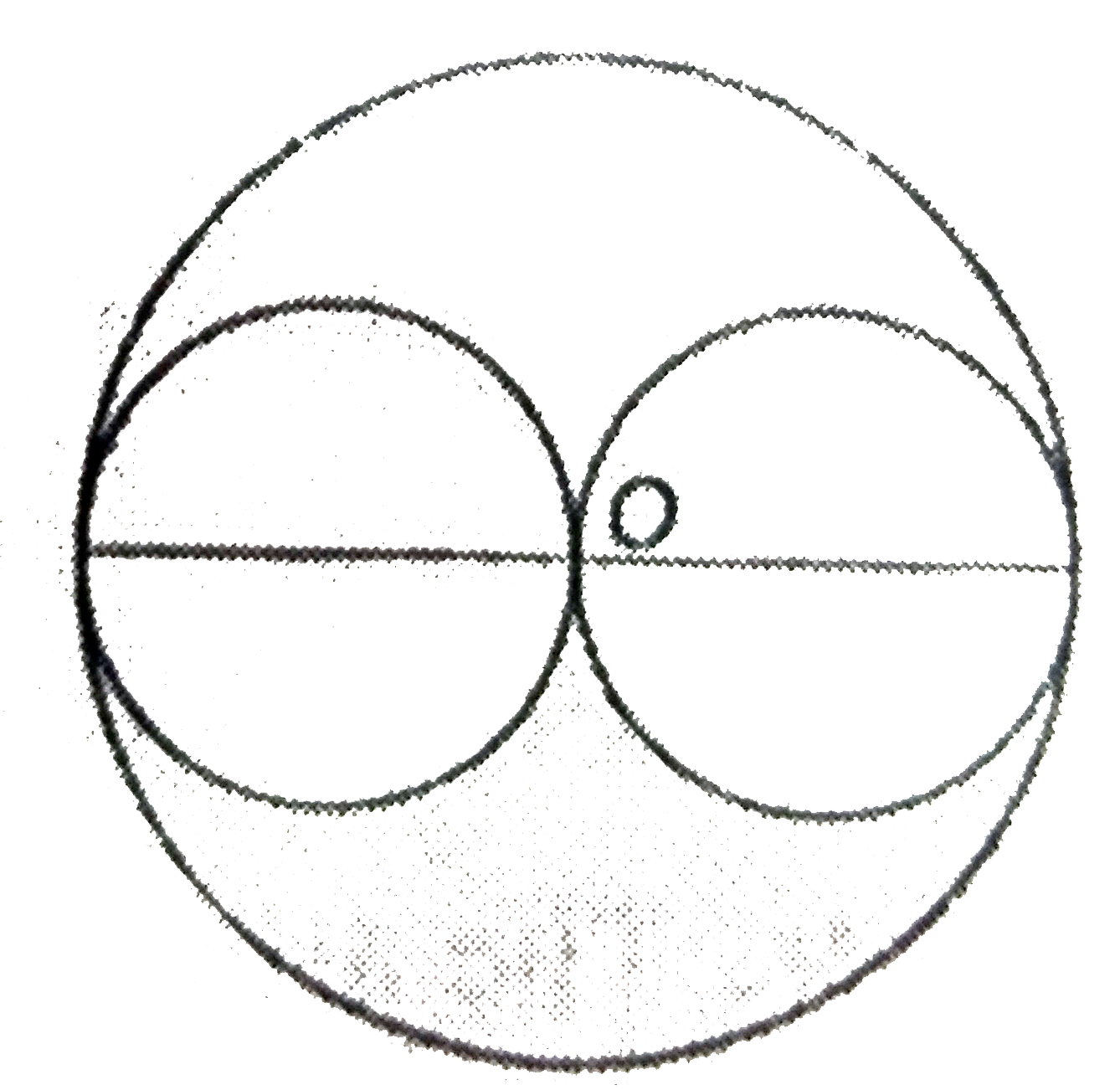If inside a big circle exactly n(n≤3) small circles, each of radius r, can be drawn in such a way that each small circle touches the big circle and also touches both its adjacent small circles, then the radius of big circle is r(1+cosecπn) (b) (1+tanπncosππ) r[1+cosec2πn] (d) r[sinπ2n+cosπ2n]2sinπnSolution in Tamil
r(1+cosec.πn)
(1+tanπ/ncosπ/n)
r[1+cosec.2πn]
r[sin.π2n+cos.2πn]2sinπ/n
The correct Answer is:A, D

If R is radius of bigger circle, then sin(πn)=rR−r
or R=r(1+cosec(πn))=r[sinπ2n+cosπ2n]2sinπn
Topper's Solved these Questions
- PROPERTIES AND SOLUTIONS OF TRIANGLEBOOK - CENGAGECHAPTER - PROPERTIES AND SOLUTIONS OF TRIANGLEEXERCISE - Exercise (Comprehension)
34 Videos
- PROPERTIES AND SOLUTIONS OF TRIANGLEBOOK - CENGAGECHAPTER - PROPERTIES AND SOLUTIONS OF TRIANGLEEXERCISE - Exercise (Matrix)
6 Videos
- PROPERTIES AND SOLUTIONS OF TRIANGLEBOOK - CENGAGECHAPTER - PROPERTIES AND SOLUTIONS OF TRIANGLEEXERCISE - Exercise (Single)
80 Videos
- PROGRESSION AND SERIESBOOK - CENGAGECHAPTER - PROGRESSION AND SERIESEXERCISE - ARCHIVES (MATRIX MATCH TYPE )
1 Videos
- PROPERTIES OF TRIANGLE, HEIGHT AND DISTANCEBOOK - CENGAGECHAPTER - PROPERTIES OF TRIANGLE, HEIGHT AND DISTANCEEXERCISE - Question Bank
15 Videos
Similar Questions
Given that Δ=6,r1=2,r2=3,r3=6
Circumradius R is equal to
View SolutionFind the derivative of y=sin−1(2–x4).
View SolutionIn ΔABC,sinA(a−bcosC)sinC(c−bcosA)=
View SolutionIt is given that in a group of 4 students, the probability of 2 students not having the same birthday is 0.893. What is the probability that the 2 students have the same birthday?
View SolutionThe area of a right triangle is 6864 sq. units. If the ratio of its legs is 143:24, then the value of r is ______
View SolutionA circle of radius R touches externally a set of 12 circles each of radius r surrounding it.Each one of the smaller circles touches two circles of the set,then ((R)/(r))=sqrt(m)+sqrt(n)-1 where m,n in N and m+n is
View SolutionA circle of radius R touches externally a set of 12 circles each of radus r surronding it. Each one of the smaller circles touches two circles of the set.Then (R)/(r)=sqrt(m)+sqrt(n)-1 where m,n in N and m+n is
View SolutionTwo circles of radius 1 and 4 touch each other externally.Another circle of radius r touches both circles externally and also one direct common tangent of the two circles.Then [(1)/(r)]=
View SolutionIf inside a big circle exactly n(n≤3) small circles, each of radius r, can be drawn in such a way that each small circle touches the big circle and also touches both its adjacent small circles, then the radius of big circle is r(1+cosecπn) (b) (1+tanπncosππ) r[1+cosec2πn] (d) r[s∈π2n+cos(2π)n]2sinπn
View SolutionA circle of radius R touches externally a set of 12 circles each of radius r surrounding it.Each one of the smaller circles touches two circles of the set.Then (R)/(r)=sqrt(m)+sqrt(n)-1, where m,n in N and m+n is
View SolutionCircles of radii 2,2,1 touch each other externally.If a circle of radius r touches all the three circles externally,then r is
View SolutionA circle is drawn in a sector of a larger circle of radius r, as shown in the adjacent figure. The smaller circle is tangent to the two bounding radii and the are of the sector. The radius of the small circle is-

View SolutionIn the given figure two small circles touch each other externally at the centre of a big circle and these small circles are touched internally by a big circle of radius 74cm. Find the area of the shaded region

View SolutionBy finding the area of a regular polygon of n sides inscribed in a circle of radius r ,show that the area of the circle is πr2
View SolutionA circle is drawn in a sector of a larger circle of radius r, as shown in the adjacent figure. The smaller circle is tangent to the two bounding radii and the are of the sector. The radius of the small circle is-

View SolutionIf inside a big circle exactly n(n≤3) small circles, each of radius r, can be drawn in such a way that each small circle touches the big circle and also touches both its adjacent small circles, then the radius of big circle is r(1+cosecπn) (b) (1+tanπncosππ) r[1+cosec2πn] (d) r[s∈π2n+cos(2π)n]2sinπn
View Solution
